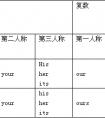The price of the socks_____ 10 yuan. [ ]A. are B. is C. does D. can -七年级英语
The wounded is a policeman. 受伤者是一名警察。
The beautiful is not always the same as the good. 漂亮的不一定就等于好。
(5) 表示时间、距离、金钱、重量等的复数名词作主语
表示时间、距离、金钱、重量、度量、容量、温度等的复数名词做主语,通常看作一个整体,谓语动词用单数形式。
Twenty years has passed since we left school. 我们离开学校已经20年了。
Ten thousand dollars is a lot of money. 一万美元是一大笔钱。
Two months is quite a long time. 两个月时间是很长的。
Two hours is enough for us to do this experiment.我们做这个实验两个小时就够了。
Thirty kilometres is a good distance.30公里是一个相当远的距离。
注意:如果说话人侧重一个个的个体,谓语动词用复数形式。
Twenty years have passed since we parted.自从我们分手以后20年己经过去了。
(6)“a number of十复数可数名词”与“the number of十复数可数名词”作主语
“a number of十复数可数名词”表示 “一些、许多”的意思,谓语动词用复数;
“the number of十复数可数名词”表示 “……的数目、数量”,谓语动词用单数。
The number of people invited was fifty, but a number of them were absent for different reasons.
邀请来的人数是50,但很多人因不同的原因没来。
A number of books are missing from the library.
图书馆丢了许多书。
The number of workers in this factory is increasing.
这家工厂的工人数目正在增加。
(7)none of和neither of后跟复数名词或复数代词作主语
none of和neither of后跟复数名词或复数代词时,有时作单数看待,有时作复数看待,主要根据说话人的意思决定。
None of them has arrived yet at the settlement. 他们没有一个到达新住宅区。
None of them have arrived yet. 他们都还没到。
(8)“分数/百分数+of短语”作主语
“分数/百分数+of短语”作主语,这时要以of短语中的名词是否为复数而定。
Two fifths of the land in that district is covered with trees and grass.该地区五分之二的土地为树木和草所覆盖。
89% of smokers are male. 89%的吸烟者是男性。
In the USA, 75% of the grain is used to feed animals. 在美国,75%的谷物用来喂养动物。
Two-thirds of the earth's surface is sea. 地球表面的2/3是海洋。
Two-thirds of the people were against the plan. 2/3的人都反对核计划。
(9)表示部分概念或不定数量的名词或代词作主语
表示部分概念或不定数量的名词或代词作主语,谓语动词用单数还是复数,应根据后接名词的单、复数形式而定。
这些名间或代词有all,any,enough,half,more,most,the rest,part,some等。
The rest of the buildings are easy to get to. 其余的建筑物并不难上。
The rest of his life was happy. 他的晚年生活很幸福。
Most of my time was spent in reading. 我大部分时间用来读书。
Most of the people are aware of it. 大部分人都知道它。
Some of the sugar was spilled on the floor. 一些糖散落在地上。
Some of the apples were spilled on the floor. 一些苹果散落在地上。
(10)两个主语,一个肯定,一个否定,谓语动词与肯定主语相一致。
The parents, and not the son, were missing.失踪者不是儿子,而是他的双亲。
3、邻近原则
邻近原则是指谓语动词要与它最邻近的名词或代词保持人称与数的一致。
Neither he nor I am a student. 他和我都不是学生。
There is a pen , two chairs and a desk. 有一支钢笔,两把椅子和一张桌子。
这主要有以下几种情况。
(1)由or,either…or等连接的并列结构作主语
由or、either…or、nor、neither…nor、not only…but also、not…but连接的并列主语,通常按照就近一致原则,谓语动词的单、复数形式依照靠近它的主语而定。
Either you or the headmaster is to hand out the prizes to these gifted students at the meeting.要么你要么校长在会议上对这些天才的学生颁奖。
Neither he nor I have finished the experiment. 他和我都没有做完试验。
Either his friends or his brother is wrong. 不是他的朋友们错了,就是他哥哥错了。
Not only I but also Jane and Mary are tired of having one examination after another.不仅我而且简和玛丽都讨厌一个接一个的考试。
Not only the teacher but also his students have studied the question. 不仅老师而且他的学生们都研究了这个问题。
(2)在主谓倒装句时
在主谓倒装句中,主语并列,谓语动词的人称和数与最近的主语相一致。由here或there引导的句子,若有并列主语,谓语也与最靠近的那个主语一致。
There is a desk, a table and three chairs in the room. 房间里有一张书桌、一张饭桌和3把椅子。
There are three chairs, a desk and a computer in the room. 房间里有3把椅子、一张书桌和一台电脑。
Where is your wife and children to stay while you are away?你不在时妻子和孩子呆在哪儿?
"表里不一"现象:
主谓一致中的"表里不一"现象
和主语必须在人称和数上保持一致,最基本的原则是:单数主语用单数动词,复数主语用复数动词.但在实际使用当中情况比较复杂,现在学生常犯的主谓一致错误归纳整理如下
1,"more than one +名词"作主语时,谓语动词常用单数.例如:
More than one teacher gets the flowers. 不止一个教师得到了花.
2,"many a +名词"作主语时,从意义上看是复数,但谓语动词常用单数.例如:
Many a student has been sent to plant trees. 很多学生被派去植树.
3,"half of,the rest of,most of,all of及百分数或分数+of 等后接名词"作主语时,谓语动词形式根据of后的名词而定.例如:
Three fourths of the surface of the earth is covered with water.地球表面四分之三为水所覆盖.
4,all指人时,动词用复数;all指物时,动词用单数.例如:
"All are present and all is going well." 所有人全部到场了,一切进展顺利
5,what引导的主语从句,谓语动词可视表语而定:表语是单数名词时,动词用单数,相反,则用复数.例如:
What they want to get are a number of good books.他们想得到的是大量的好书.
6,and连接的两个单数名词前若用each,every,no修饰,该名词短语作主语时,谓语动词用单数形式.例如:
No book and no pen is found in the schoolbag.书包里没有书和钢笔.
7,当主语后面有as well as,with,along with,together with,but,like,rather than,except,逗号加and连接几个名字等引导的短语时,谓语动词要与最前面的主语保持一致.例如:
My father as well as his workmates has been to Beijing. 我父亲和他的同事曾去过北京.
8,each作主语的同位语时,谓语动词由主语来决定,与each无关.例如:
They each have a bike. 他们每人有一辆自行车.
9,动词不定式,动词-ing形式短语作主语时,谓语动词常用单数.例如:
Going out for a walk after supper is a good habit.晚饭后出去散步是一个好习惯.
10,the following作主语时,谓语动词的数与后面名词的数保持一致.例如:
The following are good examples下面是一些好例子.
11,以-ics结尾的学科名词,如politics,physics,mathematics等作主语时,谓语动词用单数.以-s结尾的名词news,works,plastics等同属此类.例如:
Politics is now taught in all schools. 现在各学校都开设政治课.
当以-ics结尾的学科名词表示"学科"以外的意义时,用作复数,如:mathematics(运算能力)politics(政治观点)economics(经济意义)等
12,有些用来表示由两个对应部分组成一体的名词复数(trousers,glasses,shoes.shorts.scissors.scales等)作主语时,前面若有"一条","一副","一把"之类的单位词,动词用单数;若没有单位词或单位词是复数,则谓语动词用复数.例如:
The shoes are all right. 这些鞋子都很合适.
还有一些以-s结尾的名词通常用复数:arms(武器).clothes.contents.minites(记录).remains(遗体).thanks等
13,"one and a half +名词"作主语时,谓语动词要用复数.例如:
One and a half apples are left on the table. 桌子上有一个半苹果.
14,"One or two more +复数名词"作主语时,谓语动词用复数.例如:
One or two persons are sent there to help them do the work. 要派一两个人到那儿去给他们帮忙.
15,"one of+复数名词+ 定语从句"结构中,定语从句的谓语动词要用复数;而在"the only one of +复数名词+定语从句"的结构中,"the one of + 复数名词+定语从句"定语从句的谓语动词要用单数.例如:
He is one of the students who get there on time.他是准时到达那里的学生之一.
16,表示时间,距离,金钱等的复数名词作主语表达一个整体概念时,谓语动词常用单数,但若强调数量,谓语动词可用复数.例如:
One million dollars is a lot of money. 一百万美元是一大笔钱.
英语可数名词的规则复数形式是在词尾加-s或-es,但是有一些以-s结尾的名词并不是可数名词。
它们用法多样,造成了实际使用上的困难,以下详述了以-s结尾的名词作主语的主谓一致问题。
(一)以-s结尾的疾病名称作主语的主谓一致问题
(二)以-s结尾的游戏名称作主语的主谓一致问题
(三)以-s结尾的地理名称作主语的主谓一致问题
- 最新内容
- 相关内容
- 网友推荐
- 图文推荐
| [家长教育] 孩子为什么会和父母感情疏离? (2019-07-14) |
| [教师分享] 给远方姐姐的一封信 (2018-11-07) |
| [教师分享] 伸缩门 (2018-11-07) |
| [教师分享] 回家乡 (2018-11-07) |
| [教师分享] 是风味也是人间 (2018-11-07) |
| [教师分享] 一句格言的启示 (2018-11-07) |
| [教师分享] 无规矩不成方圆 (2018-11-07) |
| [教师分享] 第十届全国教育名家论坛有感(二) (2018-11-07) |
| [教师分享] 贪玩的小狗 (2018-11-07) |
| [教师分享] 未命名文章 (2018-11-07) |

![The jeans_____ fit for me, maybe, the pair of jeans _____fitter for me.[ ]A.are; are B.is; is C.is ;areD.are; is-八年级英语](http://www.00-edu.com/d/file/ks/4/2/xidongci/2020-01-05/small4952a8c67458a8ae95f5f8e3ea8b4bf91578154110.png)
![Here _____some flowers.[ ]A.isB.areC.amD./-七年级英语](http://www.00-edu.com/d/file/ks/4/2/xidongci/2020-01-04/smallef3acfcb329d087ede3710c354ecc9151578152853.png)
![The price of the socks_____ 10 yuan. [ ]A. are B. is C. does D. can -七年级英语](http://www.00-edu.com/d/file/ks/4/2/xidongci/2020-01-04/small6e5d2db89e73d5a89d7deae9143a225a1578153319.png)


